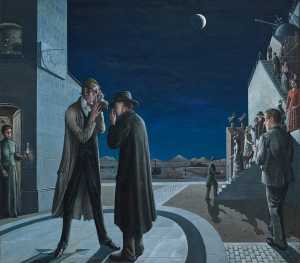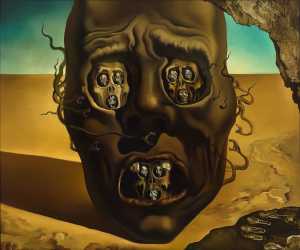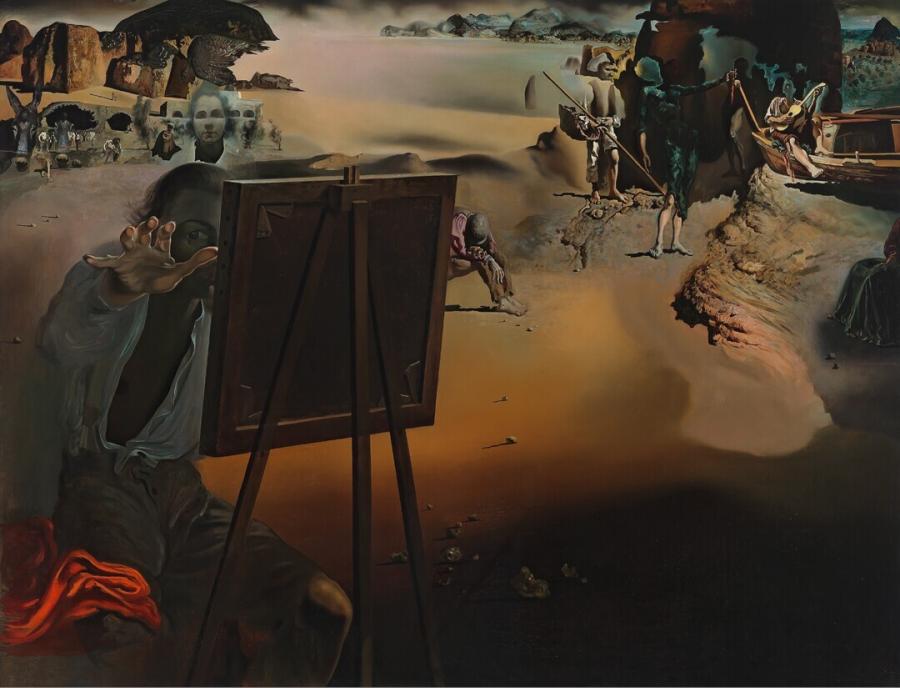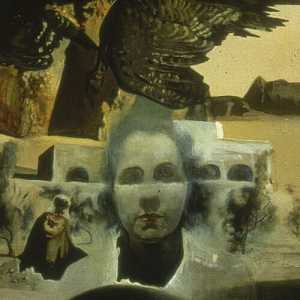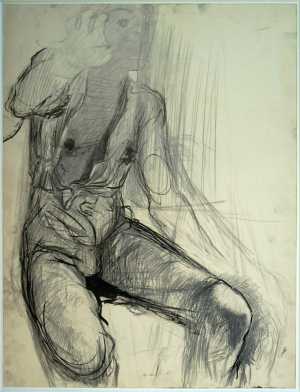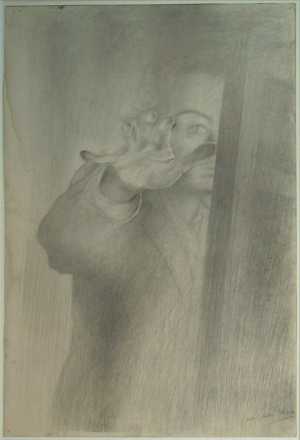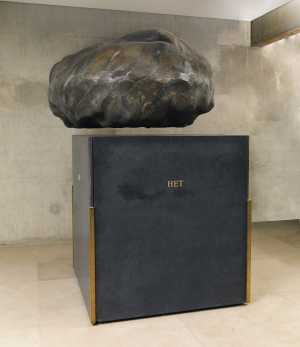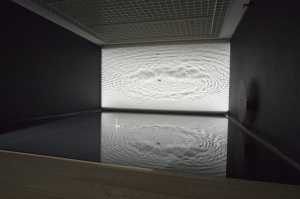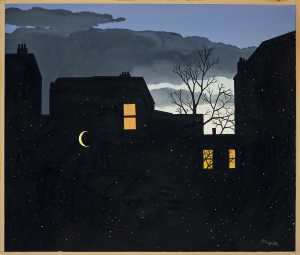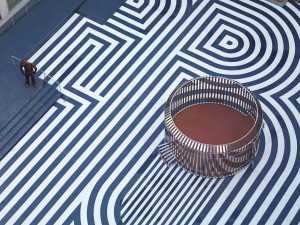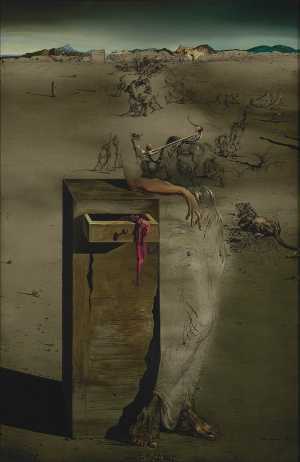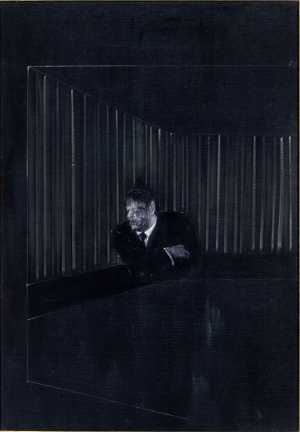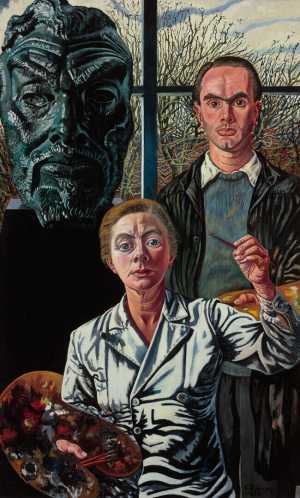Dalí sits behind his easel with his wife Gala's face above his head. Her eyes merge with the arcades of a building, a typically Dalían double image. The title is taken from the Raymond Roussel absurdist novel of 1910, which was later adapted for the stage. Dalí never went to Africa himself; the scenery is inspired by the landscape near his house at Port Lligat.

Specifications
| Title | Impressions d'Afrique |
|---|---|
| Material and technique | Oil on canvas |
| Object type |
Painting
> Painting
> Two-dimensional object
> Art object
|
| Location | This object is in storage |
| Dimensions |
Width 117,5 cm Height 91,5 cm |
|---|---|
| Artists |
Artist:
Salvador Dalí
|
| Accession number | 2991 (MK) |
| Credits | Purchased with the support of Stichting Museum Boijmans Van Beuningen, Rembrandt Association, Cultuurfonds, Erasmus Foundation, and Stichting Bevordering van Volkskracht, 1979 |
| Department | Modern Art |
| Acquisition date | 1979 |
| Creation date | in 1938 |
| Collector | Collector / Edward James |
| Entitled parties | © Salvador Dalí, Fundación Gala-Salvador Dalí, c/o Pictoright Amsterdam 2022 |
| Provenance | Edward James, Chichester 1938-64; Edward James Foundation, Chichester 1964-79; on loan to Tate Gallery, London |
| Exhibitions | New York 1941-42; Indianapolis 1942; Detroit 1943; New York 1965; Rotterdam 1970-71; London 1971; Paris 1979; Barcelona/Madrid 1983; Charleroi 1985; Paris 1987-88; Madrid 1988; Stuttgart/Zurich/Humlebaek 1989-90; Brighton 1998; Hartford 2000; Paris/Düsseldorf 2002; Venice/Philadelphia 2004-05; Stuttgart 2009-10; Milan 2010-11; Paris/Madrid 2012-13; Rotterdam 2013-2014a; Edinburgh/Hamburg/Rotterdam 2016-17 |
| Internal exhibitions |
Een paraplu, een naaimachine en een ontleedtafel. Surrealisme à la Dalí in Rotterdam. (2013) Gek van surrealisme (2017) Lievelingen (2024) |
| External exhibitions |
Salvador Dalí. The Man-The Artist (2012) Dalí (2012) Dalí - All of the poetic suggestions and all of the plastic possibilities (2013) Surreal Encounters - Collecting the Marvellous (2016) Dalí, Ernst, Miró, Magritte... (2016) Only the Marvelous is Beautiful (2022) Dal nulla al sogno (2018) A Surreal Shock – Masterpieces from Museum Boijmans Van Beuningen (2021) A Surreal Shock. Masterpieces from Museum Boijmans Van Beuningen (2023) Surrealist Art - Masterpieces from Museum Boijmans Van Beuningen (2021) Dalí, Magritte, Man Ray and Surrealism. Highlights from Museum Boijmans Van Beuningen (2023) |
| Research |
Show research A dream collection - Surrealism in Museum Boijmans Van Beuningen |
| Literature | Soby 1946, pp. 16, 22, 64; Rotterdam 1970, cat. no. 62; Paris 1979, p. 311, fig. 251; Ades 1982, p. 139, fig. 103; Stuttgart/Zurich 1989, pp. 264-65, cat.no. 207; Descharnes 1997, p. 241; Gibson 1997b, pp. 364, 380; Figueres 2004-present, cat. no. 462; Venice/Philadelphia 2004-05, pp. 290, 293, fig. 179; Milan 2010-11, pp. 90-91, 93; Paris/Madrid 2012-13, p. 203; Edinburgh 2016, pp. 8, 198, 217, 246, cat. no. 35 |
| Material | |
| Object | |
| Geographical origin | Spain > Southern Europe > Europe |
Entry catalogue A dream collection - Surrealism in Museum Boijmans Van Beuningen
Author: Marijke Peyser
The title of the painting, Impressions d’Afrique, was borrowed from a novel by Raymond Roussel published in 1910. His ideas were highly rated by the Surrealists, and Salvador Dalí also admired the author and his work.[1] Roussel’s approach was similar to Dalí’s: the writer created double or multiple images in language by using homonyms, while the painter depicted scenes according to his ‘paranoiac-critical method’.[2]
Impressions d’Afrique shows Dalí working on a painting of which we only see the back. Behind the painter’s head is the face of Gala, his muse. There are numerous double images in this work: Gala’s eye sockets coincide with the arcade of a building. The outline of the body of a priest is also the head of a donkey.[3] The entrance to a cave at the same time suggests a tree. The long branches of a pine tree also represent a bird of prey. And in the background there are the tiny figures of a father figure and his little son; a motif that the painter frequently used after he was banished from his parent’s house in 1929.[4]
Classical influences are also evident in this painting. In his autobiography La vie secrète de Salvador Dalí (1952) he described his interest in Classicism.[5] Before the outbreak of the Second World War he stayed in Italy on three separate occasions for prolonged periods and saw the work of the architects Palladio and Bramante and paintings by Botticelli, Di Cosimo, Raphael and Uccello.[6] This new orientation appears in Impressions d’Afrique.[7] Dalí was inspired, for instance, by the foreshortening in the work of Caravaggio and others. In The Supper at Emmaus (1601) Caravaggio conveyed the emotions in the Bible story through the gestures of Jesus and the disciple Cleopas, who sits on his left. More important, though, is the artist’s foreshortening of the two men’s arms, which consequently seem to draw the viewer into the scene. Dalí used a similar gesture in Impressions d’Afrique. He had explored this foreshortening technique in the two preliminary studies (Self-portrait (study for 'Impressions d'Afrique' I) and Self-Portrait (study for 'Impressions d'Afrique' II)).
Las Meninas (1656) by the Spanish artist Diego Velázquez was a second connection with classical painting. Like Velázquez, Dalí portrayed himself painting and we see only the back of the canvas. In the seventeenth-century painting, the figures of King Philip IV and his second wife Maria Anna of Austria can be seen in a mirror on the back wall of the room. This puts the viewer in the same place as the royal couple so that the viewer sees what they see and forms part of the scene. This canvas was the ultimate achievement of Philip IV’s court painter, who self-confidently set about showing just what painting could do. The classical principles of ‘imitation’ and ‘emulation’ – imitating great predecessors and trying to surpass them – were also adopted by Dalí in the twentieth century.
Footnotes
[1] Éluard 1984, p. 162.
[2] Homonyms are words that when written look the same but have different meanings. For more about Dalí’s paranoiac-critical method see p. 79.
[3] This is a reference to Dalí and Buñuel’s anticlerical feelings. This attitude is expressed clearly in the film Un chien andalou, which they made in 1929.
[4] See for example Dalí enfant avec son père (1971), illustrated in Descharnes/Néret, 2005, p. 587. For more about his banishment from his parent’s house, see p. 99.
[5] Dalí 1952, pp. 390-91.
[6] Soby 1969, pp. 21-22.
[7] Ibid., p. 23.
All about the artist
Salvador Dalí
Figueras 1904 - Figueras 1989
Salvador Dali got to know the author André Breton - the founder of the surrealist movement - while he was studying in Madrid. In 1924, Breton wrote the first...
Bekijk het volledige profiel

